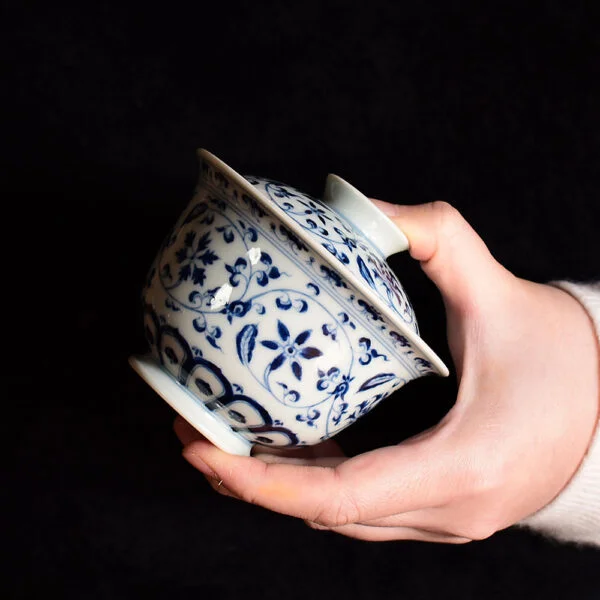This Gaiwan is handcrafted using the technique of Blue-and-white underglaze colour and enamel glazed painting. The design features a pattern of butterflies amid flowers, displaying rich and lifelike colours, creating a unique and charming ambiance.
Blue and White Enamel is a distinctive porcelain decoration technique that combines the traditional methods of blue and white with enamel. It is a variation of the traditional Chinese porcelain production, blending the characteristics of blue and white with enamel, resulting in a captivating and unique decorative style.
Blue and White refers to the technique of painting blue patterns on the porcelain surface. It originated during the Yuan dynasty but reached its peak during the Ming and Qing dynasties. This decorative method uses cobalt oxide blue pigments that fuse with the porcelain surface at high temperatures, ensuring the patterns’ durability.
Enamel, on the other hand, is a decorative technique that involves transplanting the cloisonné enamel method onto a porcelain body as an overglaze colour decoration. Enamel decoration on porcelain, known as “Fàlángcǎi” in Chinese, entails painting colourful patterns on the porcelain surface and then firing it at high temperatures to fuse the colours with the porcelain, achieving a durable and splendid design. These patterns often feature exquisite themes such as flowers, birds, figures, and landscapes, reflecting the essence of traditional Chinese culture and art.
The process of creating enamel decorations is extremely intricate and complex, requiring skilled and experienced craftsmen. First, the porcelain prototype is made, and then special mineral pigments are used to paint patterns on its surface. Once the painting is completed, a series of firing processes follow, during which the temperature and timing for both the porcelain and the enamel colours are crucial factors. Improper temperature or timing can result in cracks in the porcelain or unstable colours. Enamel decoration is considered a treasure in traditional Chinese craftsmanship, representing the wisdom and skills of ancient Chinese artisans.
The combination of blue and white enamel unites these two techniques, typically starting with the blue and white technique to depict blue patterns, and then applying enamel decoration to add additional colours and enhance the visual effect and three-dimensional sense of the design. This decorative method enriches the patterns on the porcelain while preserving the distinctive features of both blue and white and enamel techniques. During the Ming and Qing dynasties, blue and white enamel reached its peak and became one of the main styles for porcelain decoration at that time.
The design of this Gaiwan showcases lifelike patterns of butterflies amid flowers. “Butterflies in Love with Flowers” symbolizes sweet love and blissful marriage. In recent times, people have endowed this motif with more profound meanings, expressing good wishes and symbolizing beautiful and prosperous love. Butterflies are often seen as symbols of happiness and love, inspiring and captivating people’s imagination, and aspirations. In traditional Chinese literature, a pair of flying butterflies represents the pursuit of free and passionate love. Butterflies are loyal to their mates, having only one partner throughout their lives, making them a symbol of fidelity in the insect world. Moreover, there is a beautiful Chinese folktale known as “The Butterfly Lovers,” which further enhances the symbolism of sweet love and harmonious marriage associated with the motif of butterflies and flowers.
This enamel-decorated Gaiwan displays a rich and colourful palette, with lively and dynamic brushstrokes, immersing people in an elegant artistic ambiance while enjoying their tea.





















There are no reviews yet.